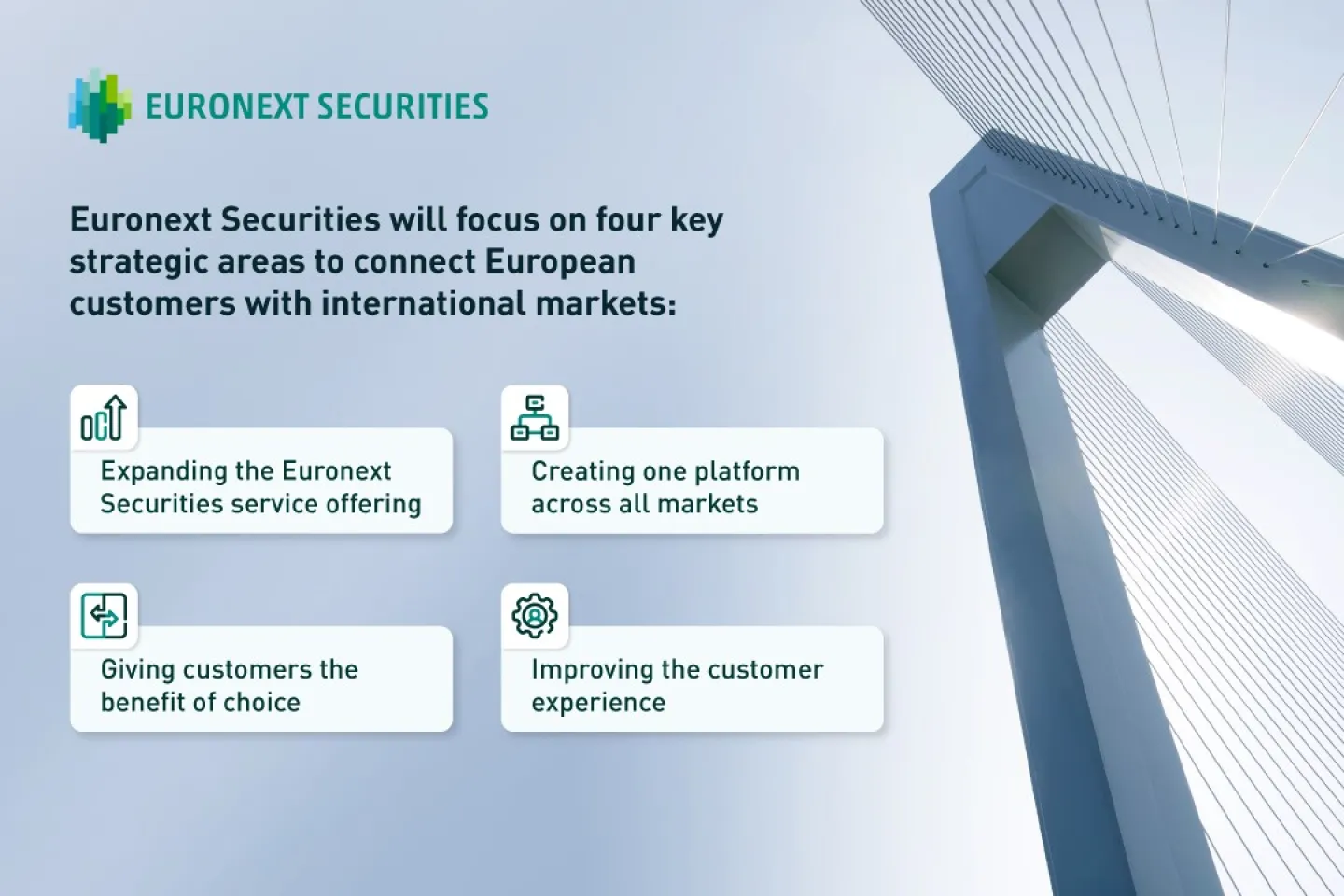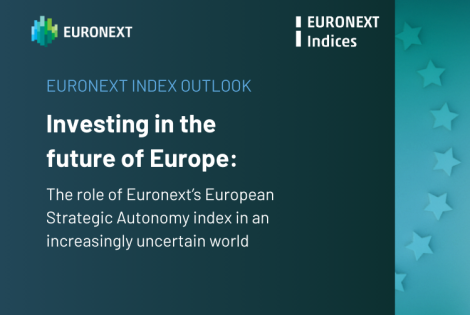On 9 November 2021, Euronext announced that the Group’s four CSDs would now operate under the name Euronext Securities, with the ambition of pan-Europeanising and scaling up the business. In this article, Pierre Davoust, Head of CSDs at Euronext, lays out the three-year CSD strategy and explains how it will address the needs of local and international customers.
“The European post-trade market is a challenging one for many of our customers to navigate,” Pierre Davoust explains. “There are over 30 CSDs, each with their own systems and processes. If you are a bank operating in multiple markets, this fragmentation creates inefficiencies in your internal processes. Although the regulatory foundation for competition has existed since 2014, we still see very little competition across borders.”
Euronext Securities will address this fragmented marketplace by creating a more harmonised and more competitive post-trade environment for its customers. As part of Euronext Group’s ‘Growth for Impact 2024’ strategy, Euronext Securities will focus on four key strategic areas to connect European customers with international markets. These pillars are designed to meet the needs of local, regional and international customers, and solve some of their most pressing pain points.
Expanding the Euronext Securities service offering
The first pillar of the strategy involves expanding Euronext Securities’ current service offering. “What we hear from our customers is that they are looking for ways of reducing costs and streamlining their operations,” Pierre Davoust explains. “Instead of having to spend resources on services that are not a part of their core business, such as back office tax operations, they are increasingly offloading these services onto third-party providers. This is where we can help, by providing these services to our customers, so they can focus on their core business.”
Converging platforms across markets
The second pillar is about convergence. “Currently, when customers do business with our different CSDs, they face different platforms, processes and customer service. Over the next three years, we will roll out common platforms in several areas and implement a common approach towards customers, so our customers will be able to access our services in a similar way, regardless of which CSD they use. This will make life easier for our customers and enable us to leverage efficiencies and best practices across CSDs.”
The most important area where customers will concretely experience this shift is in Corporate Actions. “This is the area where we have the most complexity and the largest number of differences between the local markets,” says Pierre Davoust. “We will roll out a common Corporate Actions platform, meaning the way customers perform Corporate Actions in Portugal, Italy, Denmark or Norway will be far more similar than it is today. This will make life much simpler for custodians who connect with Euronext.”
Giving customers the benefit of choice across Europe
Third, Euronext Securities will scale up its activities across the continent. “Euronext is the leading pan-European market infrastructure. As a CSD business, we want to support Euronext’s listing and trading activities across Europe. We do not plan to build a new International CSD but will definitively look to expand our services in a targeted manner outside of our legacy markets.” This expansion will bring the benefit of competition to customers who are active on Euronext markets. “We will bring choice, better prices and better quality of service,” Pierre Davoust explains.
Improving the customer experience
The final strategic pillar focuses on the customer experience. “CSDs have a legacy of being at the centre of the market infrastructure, and as such they have been less commercially oriented than the banks themselves,” Pierre Davoust says. “However, we want to give our customers a better experience, offering them efficient client query tools, and more intuitive interfaces. So, we will invest in the customer experience to make it easier for our customers to use our services than it is today.”
Euronext Securities: working towards 2024
While customers will experience the benefits of these projects as they are rolled out, work to implement the overall strategy will continue over the next three years. By the end of that period, customers will benefit from a harmonised organisation that efficiently connects them with the European markets. “In 2024, our clients will see one united team speaking with one voice about what Euronext Securities can do for them. Across our four CSDs, customer will be able to handle key processes such as corporate actions, proxy voting, general meetings and shareholder registry – all in one place. And they will see one common ambition for response time and one way of managing client service.”

Euronext Securities: combining global reach with local expertise
One of the cornerstones of Euronext’s CSD strategy is to leverage the strengths of the local markets to benefit customers across the entire network of CSDs. Customers benefit from this in several key ways.
New, value-added services
Value-added services developed in one CSD can be scaled up and introduced to customers in other markets. This is the case in Euronext Securities Milan. “We are in the process of launching new services around General Meetings for our Italian customers,” relates Mauro Dognini, CEO of Euronext Securities Milan. “This is a new area for us, but not for our colleagues in Norway and Denmark. We have worked closely with them on this project, and are able to leverage their multi-year experience in offering this service, which helps us to bring this new product to market.”
Innovative customer-facing solutions
Audun Bø, CEO of Euronext Securities Oslo, highlights the increased investment capacity as another key benefit of the new organisation. “As part of a network of four CSDs, we have increased scale and investment capacity, compared to when we were a standalone entity,” he says. “This investment capacity is essential for developing client solutions, and it’s what makes, for example, a common, harmonised platform for corporate actions possible.”
Access to a broader range of expertise
Operating as a pan-European organisation also increases each CSD’s ability to attract and retain new talent, according to Niels Hjort Rotendahl, CEO of Euronext Securities Copenhagen. “We operate in a highly specialised part of the financial sector, and one of the challenges we had as an independent CSD was being able to attract and retain talented employees. Now that we’re part of a larger, international organisation, we’re more attractive as an employer, because we can offer a wider array of international career opportunities.” This benefits customers as well, as they can tap into a deeper well of expertise and competences across the Euronext Securities CSD network that covers the entire value chain, from issuer to investor.
Global market access with a local touch
Euronext Securities is one brand, but it is not one CSD. By preserving local presence, licences and relationships with regulators and central banks, Euronext Securities will continue to cater to customers’ individual needs in each local market. As Pierre Davoust explains, “In the market, we see two types of clients. We have global or pan-European institutions that are our clients in all markets, and they want harmonisation, because that’s the way for them to reduce their costs and risk. Then we have the local and regional players, and what they want is to be serviced in their local language, with local counterparties, and with specific services that meet their local set-up. As an organisation, we have projects and services that cater to these two groups.”
For example, Euronext Securities Copenhagen and Oslo offer a range of value-added services around tax reporting and corporate actions to Nordic customers, facilitated by the region’s segregated account structure, often called ‘the Nordic model’. “Our segregated accounts model is unique, both with regards to investor protection and also with regards to the services we can offer based on this model,” Niels Hjort Rotendahl explains. “While there is a certain amount of complexity associated with it, the model also gives us a wide range of advantageous possibilities, transparency and services.”
Pierre Davoust points out that by creating a two-tiered infrastructure, Euronext Securities can address the needs of both global and local or regional customers. “We have a backbone that is the same for everyone, and then we have the value layer, which is locally coloured, so if customers want to have just the backbone, they can do that. And if they want to have the backbone plus the services, then they can choose that option as well.”
Harmonisation that benefits customers of all sizes
And while the larger, international institutions might be the driving force behind harmonisation, Olga Jordão, CEO of Euronext Securities Porto and Head of CSD Client Services, highlights how harmonisation really benefits everyone. “The current fragmentation of the CSDs has a cost for all of our clients. So everyone will benefit from a more harmonised service model, from more streamlined processes and from a shorter value chain, which will reduce their costs, while keeping that local touch where necessary. We will be able to offer new, value-added services to our local clients, because in the end, what this model will mean for them is that the door to other European markets will be open even wider.”







